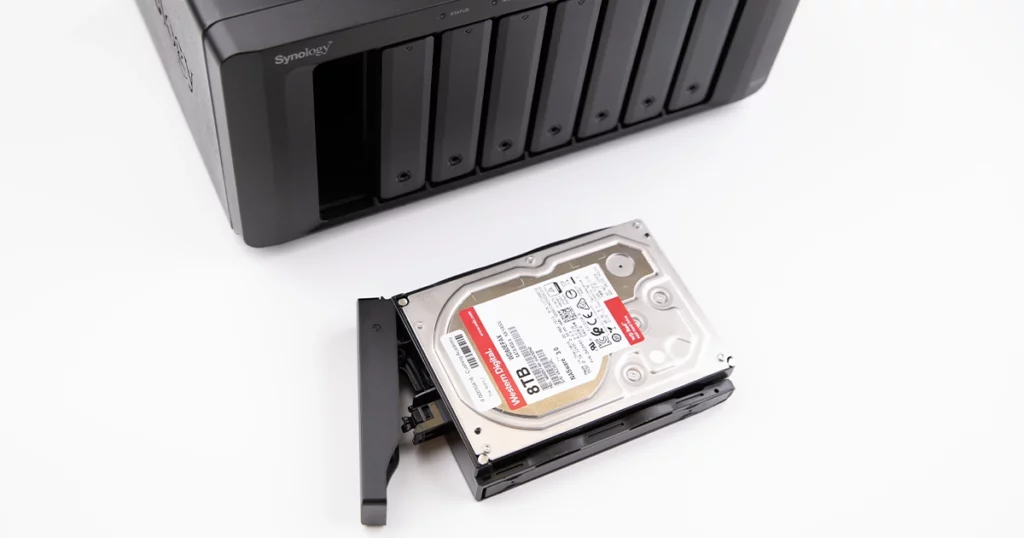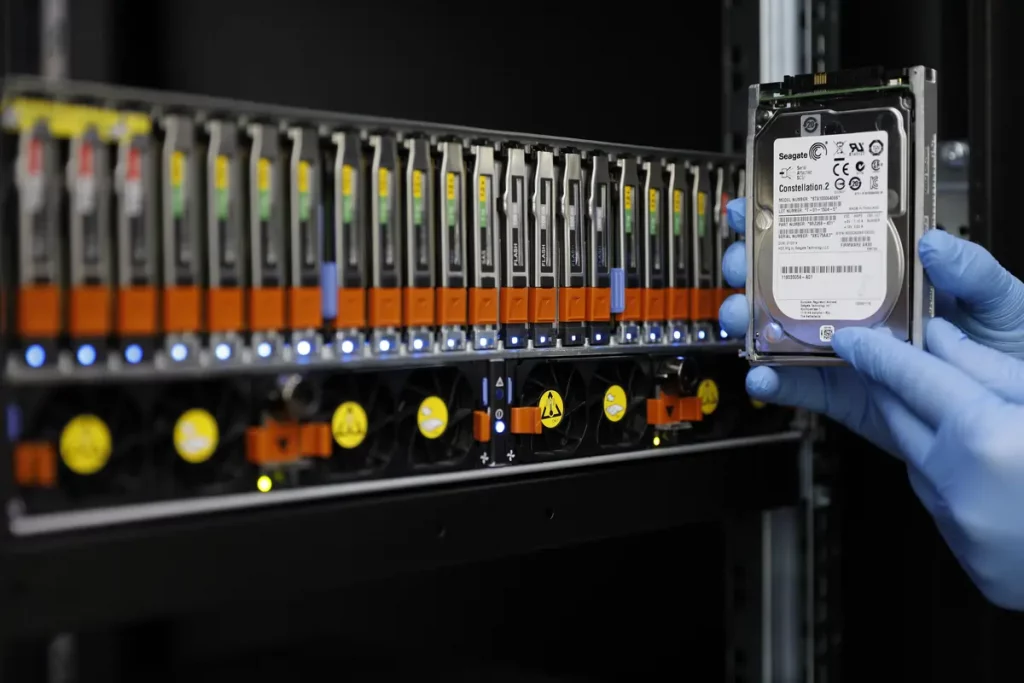As data volumes continue to climb, enterprises need storage platforms that bring together speed, capacity and resilience in a single architecture. RAID 60 delivers a balanced option for organisations running large scale workloads and requiring strong fault tolerance.
This configuration blends the strengths of RAID 0 and RAID 6, offering both performance and protection. It is widely deployed in servers, data centres and virtualised environments where uptime and reliability are critical.
In this guide, you will see how RAID 60 works, where it performs well and where it has limitations, and how data recovery specialists approach failures in these more complex RAID 60 deployments.

How RAID 60 Works
RAID 60 combines the striping used in RAID 0 with the dual parity of RAID 6 to create a layout that balances speed with data protection. It requires a minimum of eight drives, organised into multiple RAID 6 groups that are then striped together to deliver higher performance.
Within each RAID 6 set, two parity blocks are spread across all disks. This allows the system to tolerate up to two drive failures per RAID 6 group without losing data. The RAID 0 layer then stripes data across these groups, boosting overall read and write throughput.
This hybrid approach is well suited to workloads that demand both high throughput and strong redundancy, such as database servers, virtual machines and large scale storage clusters.
Although RAID 60 offers strong performance and resilience, it also consumes substantial capacity and requires careful planning and management to remain stable.
To understand the underlying principles in more detail, see our guide on What is RAID 6 for a closer look at how dual parity protection functions.

RAID 60 vs Other RAID Levels
To understand how RAID 60 stacks up against other options, here is a concise overview of how it differs from RAID 50 and RAID 6.
Here is a detailed comparison:
If you would like a deeper comparison of these higher level configurations, visit RAID 50 vs RAID 60 to explore performance and redundancy differences in more detail.
Advantages of RAID 60
RAID 60 delivers strong performance and resilience, which makes it a solid choice for high demand systems. Key benefits include:
High fault tolerance: Each RAID 6 group can tolerate up to two drive failures, significantly reducing the risk of full array data loss.
Improved performance: The RAID 0 striping layer increases read and write throughput, which is ideal for workloads that require fast, consistent data access.
Scalability: You can add additional drives or RAID 6 groups to grow capacity with minimal disruption to live services.
Balanced workload distribution: Data and parity are spread evenly across the array, helping to maintain predictable performance under load.
Suited to enterprise environments: Well matched to organisations running virtualisation platforms, database clusters and large scale storage systems
For a wider view of how other layouts compare, take a look at our post on Types of RAID.
Limitations of RAID 60
Although RAID 60 delivers strong protection and performance, it also has several drawbacks that you should weigh carefully before rolling it out.
High cost of implementation: The configuration needs at least eight drives and capable RAID controllers, which can significantly increase hardware spend.
Reduced storage efficiency: Dual parity within each RAID 6 group reduces the overall usable capacity when compared with RAID 50.
Complex configuration: Managing multiple RAID layers is more involved and requires skilled administration to avoid configuration mistakes and stability issues.
Long rebuild times: When a drive fails, replacing it and rebuilding parity can take a considerable amount of time, particularly with high capacity disks.
Risk during rebuild: If another drive fails within the same RAID group while a rebuild is in progress, data from that group may become unrecoverable.
To understand potential reliability risks in more depth, review our guide on RAID Failure Rate.

Fast turnaround times for business-critical data
Data Recovery from RAID 60 Arrays
Recovering data from a failed RAID 60 configuration can be complex because of its layered structure and dual parity design. Failures may involve individual disks, RAID controllers or logical corruption affecting one or more of the underlying RAID 6 groups.
In some situations, incorrect rebuild attempts or parity synchronisation issues can make data loss significantly worse. This is why carrying out recovery in a controlled lab environment is essential.
At RAID Recovery Services, our engineers use advanced toolsets to reconstruct each RAID 6 group before rebuilding the full RAID 60 volume. The process typically involves:
Identifying drive order and detailed configuration parameters
Repairing or reconstructing damaged parity blocks
Extracting and validating recovered data before it is returned
These steps help ensure that the recovered files remain accurate, consistent and fully usable.
If you suspect your RAID 60 system has failed, stop further rebuild attempts and contact a professional team immediately.
You can also visit our guides on Troubleshoot RAID Failure and RAID Controller Failure Recovery to learn more about dealing with critical RAID and controller issues.

Is RAID 60 Right for Your Business?
RAID 60 is most appropriate for enterprises that need both strong performance and a high level of fault tolerance. If your organisation runs heavy workloads, database servers or virtualised platforms where uptime is critical, this configuration can provide a stable and resilient foundation.
It is less suitable for smaller businesses with tighter budgets or straightforward storage requirements. In these environments, the cost, maintenance overhead and configuration complexity can outweigh the benefits.
Before you deploy RAID 60, assess factors such as scalability, available hardware and your end to end recovery strategy. Even with robust redundancy, unexpected failures can still occur.
When they do, RAID Recovery Services is ready to assist. Our team specialises in diagnosing and recovering data from complex RAID infrastructures, including RAID 60 arrays.
For more insight into what causes RAID failures, visit Reasons for RAID Data Loss.
Trust the experts with proven results
Frequently Asked Questions
What is RAID 60 used for?
RAID 60 is designed for enterprise environments that require both high performance and strong fault tolerance. It is commonly used in database servers, virtualisation platforms and data centres that handle large, sustained workloads.
How many drives are required for RAID 60?
A RAID 60 configuration requires at least eight drives, as it is built from multiple RAID 6 groups that are striped together. Each RAID 6 group needs a minimum of four disks to provide dual parity protection.
How reliable is RAID 60 compared to other RAID levels?
RAID 60 offers higher reliability than RAID 50 because it uses dual parity. This means each group can withstand up to two drive failures without losing data, making it one of the most resilient configurations.
Can RAID 60 arrays fail?
Yes. Despite its strong redundancy, RAID 60 arrays can still fail due to controller faults, multiple drive failures within the same group or user errors during rebuild or reconfiguration. Regular monitoring, firmware management and professional maintenance help to reduce these risks.
How is data recovered from a failed RAID 60?
Data recovery typically involves reconstructing each underlying RAID 6 group first, then rebuilding the complete RAID 60 array. At RAID Recovery Services, our specialists use advanced tools to restore parity information, reassemble the array and recover your data safely.